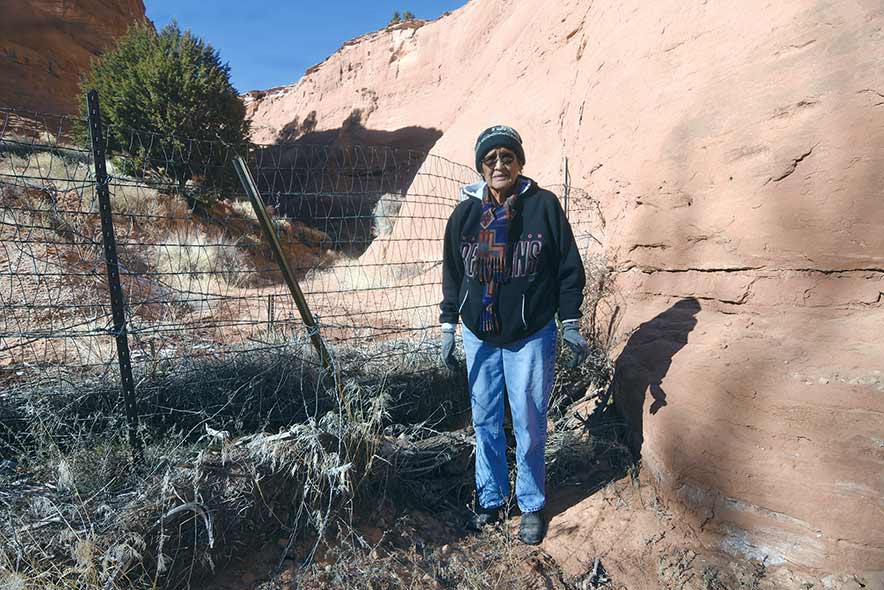
Elder reclaims grazing land, with a little help

Navajo Times | Ravonelle Yazzie
Joan Delgai, 74, stands near a makeshift dam that she built to prevent soil erosion around her home in Cornfields, Ariz.
BOULDER, Colo.
Joan Delgai had always run a few sheep on the grazing permit she inherited from her parents in Cornfields, Arizona. But after 44 years as a teacher, she decided three-and-a-half years ago to retire and go back to the land full-time.
The problem was, it wasn’t the same land she remembered.
“As I walked around my land, I saw all these deep gullies that weren’t there when I was small,” she said. “Some were just feet from the house.
“It was like Mother Nature, who used to help us, has now decided to destroy.”
Delgai didn’t blame her. “Nobody takes care of the land these days,” she sighed. And for the past 44 years, she had to include herself.
But all that was about to change. At 70, Delgai decided to reclaim her range.
She says she went to the tribe and the colleges, but though she got some encouraging words, nobody really came through with the knowledge and resources she was hoping for.
“The attitude I got from them was, ‘Yes, good idea,’” Delgai recalled. “‘Now go do it and leave us alone.’”
But help was closer at hand than she realized. One day, attending a cultural presentation by her former colleague at the Ganado School District, Ernest Begay, she realized her old acquaintance might be turned into an ally.
Recalled Begay, “She asked me, ‘Do you know anything about soil conservation?’”
Begay laughed. “How much do you want to know?” he responded.
She had just tapped Begay’s pet subject. The son of a Civilian Conservation Corps member, Begay had been doing soil conservation since he was a kid.
‘My dad made us help with projects since we could hold a shovel,” Begay recalled. “There’s one project we did in the 1950s. It was a wash four feet deep. Today, I can’t even find it.”
Begay walked Delgai’s land with her and agreed she was losing a lot of soil.
“There’s no shortcut to this project,” he warned, eyeing the slight septuagenarian. “You’ve got to do a lot of physical work.”
“I’m not afraid of work,” responded Delgai.
Begay himself was no spring chicken at 63. But the two elders dug in, beginning with the big wash that started in the hillside behind Delgai’s home.
“You always start as close to the source as you can,” advised Begay. “It’s much easier to stop water before it gathers speed.”
“Where will we get the materials?” asked Delgai.
“You already have everything you need,” responded Begay, pointing to the rocks and brush all over the property.
After that, Begay came over often to help Delgai with her land. They created three big dams of rock, brush and logs and a number of smaller ones. Jim Bydone, a natural resource technician with the BIA who Delgai says was the only government official to respond to her pleas for help, connected her with some T-posts and other materials.
Begay admits he had underestimated Delgai.
“Sometimes I would look back and there she would be, pounding in a fence post or hauling rocks,” he said. “She was keeping up with me.”
Delgai says the secret is not to think about your age.
“I hardly ever think about how old I am,” she shrugged. “If I see work that needs to be done, I do it. I may not do it as fast as a younger person, but it gets done.”
“Our people are made for hard work,” agreed Begay. “When we don’t exercise, that’s when we get health problems.”
Three and a half years later, the land is starting to respond. Several feet of silt has built up behind the makeshift dams. Plants are growing where once there was nothing but bare sand.
“I’m so happy with the results,” Delgai said. “I’m so happy I finally found two men who were willing to help me.”
She said she invited several government officials out to see the results, but Bydone was the only one who came.
Begay said the Navajo Nation does not support soil conservation like it used to.
“During the MacDonald administration, they started an award for conservationist of the year,” he said. “I won in 1994. I think they should get that going again and give it to Miss Delgai.”
He added that the recent sesquicentennial of the Treaty of 1868 should give all Navajos pause to reflect on their relationship with the land.
“My father always told us about the Long Walk,” he said, “how the people cried and begged to come back to their homeland, because it was something special.
“If that’s true, then we need to take care of the land and not take it for granted,” he said. “A grazing permit is not just a piece of paper, it’s a responsibility.”








 Highway 264,
Highway 264, I-40, WB @ Winslow
I-40, WB @ Winslow